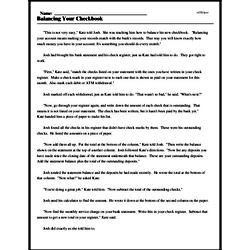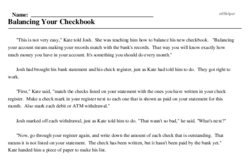Balancing Your Checkbook
"This is not very easy," Kate told Josh. She was teaching him how to balance his new checkbook. "Balancing your account means making your records match with the bank's records. That way you will know exactly how much money you have in your account. It's something you should do every month."
Josh had brought his bank statement and his check register, just as Kate had told him to do. They got right to work.
"First," Kate said, "match the checks listed on your statement with the ones you have written in your check register. Make a check mark in your register next to each one that is shown as paid on your statement for this month. Also mark each debit or ATM withdrawal."
Josh marked off each withdrawal, just as Kate told him to do. "That wasn't so bad," he said. "What's next?"
"Now, go through your register again, and write down the amount of each check that is outstanding. That means it is not listed on your statement. The check has been written, but it hasn't been paid by the bank yet." Kate handed him a piece of paper to make his list.
Josh found all the checks in his register that didn't have check marks by them. These were his outstanding checks. He listed the amounts on a piece of paper.
"Now add them all up. Put the total at the bottom of the column," Kate told Josh. "Then write the balance shown on the statement at the top of another column. Josh followed Kate's directions. "Now list any deposits you have made since the closing date of the statement underneath that balance. These are your outstanding deposits. Add the statement balance plus the total of the outstanding deposits."
Josh totaled the statement balance and the deposits he had made recently. He wrote the total at the bottom of that column. "Now what?" he asked Kate.




